-
Saturday, 11 May 2019 - 7pm
Session 1. The Wretched of the Earth I: The Anti-Colonial Revolt
Matadero Cinematheque, Azcona Theatre
Sarah Maldoror
Monangambée
Algeria, 1969, b&w, original version in French with Spanish subtitles, 16mm transferred to digital, 17’Sambizanga
Angola and France, 1972–1973, colour, original version in Portuguese, Lingala and Mbundu with Spanish subtitles, 16mm transferred to digital, 102’Presented by: Sarah Maldoror
Two of the film-maker’s landmark films are screened in this session: Firstly, Monangambée, a chant meaning “white death” and a customary war cry against colonial exploitation in Angola. This short film describes the culturally incomprehensible abuses of Portuguese civil servants in the African country after the torture of a prisoner. Secondly, Sambizanga, a fictional feature-length film on the arrest of a member of the Movement of the Liberation of Angola and his wife and son’s relentless search for him. The film offers a feminist view against bureaucracy and the brutality of colonialism.
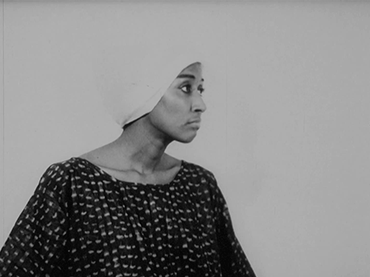
-
Sunday, 12 May 2019 - 7pm
Session 2. The Wretched of the Earth II: The Anti-Colonial Revolt
Sabatini Building, Auditorium
Gillo Pontecorvo (assistant director: Sarah Maldoror)
La battaglia di Algeri (The Battle of Algiers)
Algeria and Italy, 1965, b/w, original version in French and Arabic with Spanish subtitles, B-R, 121’Presented by: Annouchka de Andrade and Olivier Hadouchi
One of the most influential political films ever made, The Battle of Algiers vividly recreates Algeria’s turbulent struggle for liberation from French rule in the 1950s. Filmed documentary style on the streets of Algiers, the film constitutes a study of contemporary war, with terrorist attacks carried out by civilians and the brutal military techniques used to combat them. In this tour de force, Sarah Maldoror worked with Pontecorvo as assistant director.
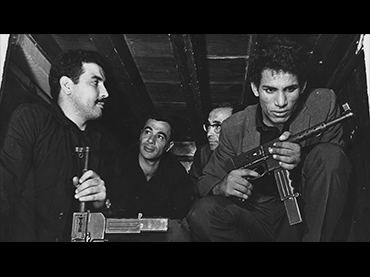
-
Monday, 13 May 2019 - 7pm
Session 3. The Wretched of the Earth III: The Anti-Colonial Revolt
Sabatini Building, Auditorium
Mathieu Klebeye Abonnenc
Préface à des fusils pour Banta
French Guyana, 2011, colour, original version in French with Spanish subtitles, digital archive, 28’Round-table discussion between Annouchka de Andrade, Olivier Hadouchi and Mathieu Klebeye Abonnenc, moderated by Chema González
A film installation on Sarah Maldoror’s lost film, Des fussils pour Banta, her first feature which was deemed too ambiguous by Algeria’s revolutionary government and therefore seized. The round-table discussion following the screening seeks at once to place Sarah Maldoror in the context of Third Cinema and to study her role in a present that is battling against new forms of colonialism, as well as the poetic and political lessons that issue forth from her films and life.
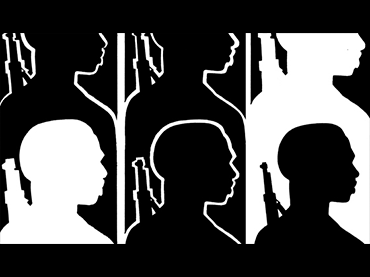
-
Tuesday, 14 May 2019 - 9:30pm
Session 4. Land and Carnival I
Matadero Cinematheque, Borau Theatre
William Klein (assistant director: Sarah Maldoror)
Festival panafricain d'Alger [The Pan-African Festival of Algiers] RFA, Algeria and France, 1970, colour, original version in French and English with Spanish subtitles, digital archive, 90’“African culture will be revolutionary, or it won’t be”, concludes this monumental fresco on Pan-Africanism as the thinking of emancipation. To the vibrant rhythm of black music by Miriam Makeba, Archie Shepp, Nina Simone and Marion Williams, the architects of new black culture appear in the film alongside the major theorists of decolonialisation and future national leaders, while texts on the screen pick apart the colonialist system and its machinery of oppression.
![William Klein. Festival panafricain d'Alger [The Pan-African Festival of Algiers]. Film, 1970 William Klein. Festival panafricain d'Alger [The Pan-African Festival of Algiers]. Film, 1970](https://recursos.museoreinasofia.es/legacy_programs/maldoror-4.gif)
-
Wednesday, 15 May 2019 - 7pm
Session 5. Land and Carnival II
Matadero Cinematheque, Borau Theatre
Sarah Maldoror
A Bissau, le carnaval
Guinea-Bissau, 1980, colour, original version in French with Spanish subtitles, digital archive, 18’Fogo, l´ile de feu
Cape Verde, 1979, colour, original version in Portuguese and French with Spanish subtitles, digital archive, 32’Un carnaval dans le Sahel
Cape Verde, 1979, colour, original version in Portuguese with Spanish subtitles, digital archive, 15’Following her experience with guerrillas and international decolonial movements, Sarah Maldoror directed a film season on new nations at the request of the governments of Guinea-Bissau and Cabo Verde. As an approach to the history of colonisation and black culture, she uses carnival, understood as a festival with which to breach limits, whereby the dominator becomes the dominated. Concurrently, carnival bursts with music and impressions, a great collective performance engendering the identity qualities of Négritude.
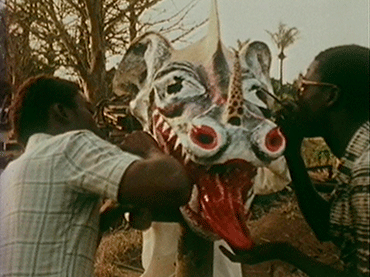
-
Thursday, 16 May 2019 - 7pm
Session 6. Poetry: Aimé Cesaire
Sabatini Building, Auditorium
Sarah Maldoror
Et les chiens se taiseient, d'Aimé Césaire
France, 1978, colour, original version in French with Spanish subtitles, digital archive, 13’Aimé Césaire au bout du petit matin
France, 1977, colour, original version in French with Spanish subtitles, digital archive, 57’This session focuses on the poet, intellectual, dramaturgist and politician Aimé Cesaire (1913–2008), author of Discourse on Colonialism (1950) and several pivotal poem collections on Négritude. In Et les chiens se taiseient (1946), Maldoror adapts a theatre piece on a rebel who, condemned to death, becomes aware of his otherness. The dialogue with his mother – both existentialist and autobiographical – reverberates around the African sculptures on display at the Museum of Man, the old Trocadéro and an institution representing French colonial plundering, and is filmed through the mediation of Surrealist anthropologist Michel Leiris. Aimé Césaire au bout du petit matin tacks, on the landscape of Martinica, poetry readings, interviews with the writer and filmed theatre in a synthesis representing, through visual metaphors, the qualities of Césaire’s writing; “beautiful as nascent oxygen”, as André Breton wrote.

-
Friday, 17 May 2019 - 7pm
Session 7. Poetry: Two Worlds, Two Poets
Sabatini Building, Auditorium
Sarah Maldoror
Louis Aragon, un masque à Paris
France, 1978, colour, original version in French with Spanish subtitles, digital archive, 20’Léon G. Damas
France, 1994, colour, original version in French with Spanish subtitles, digital archive, 26’This session brings together the last Surrealist poet in the inter-war period and the first in the new Surrealism of Négritude seen by Sarah Maldoror. Louis Aragon (1897–1982) is depicted with a red mask before his imagined museum, a huge archive of portraits, photographs and books, amassed in a disappearing world. Leon G. Damas (1912–1978), meanwhile, was the first poet to “live Négritude”, according to Leopold Senghor. Cosmopolitan and always in transit, his writing is a chorus of melodies and images imbued with angst and melancholy, and strongly influenced by jazz, blues and black music. This film, shot to the landscapes of Guyana with the voice of the artist, emerges from Maldoror’s keenness to create a poetic documentary.
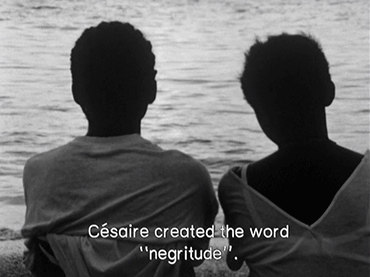
-
Saturday, 18 May 2019 - 7pm
Session 8. The Women
Sabatini Building, Auditorium
Ahmed Lallem (assistant director: Sarah Maldoror)
The Women
Algeria and France, 1966, colour, original version in French and Arabic with Spanish subtitles, 35mm, 22’Sarah Maldoror
Toto Bissainthe
Haiti, 1984, colour, original version in French with Spanish subtitles, digital archive, 4’Ana Mercedes Hoyos
France and Colombia, 2009, colour, Spanish, digital archive, 13’In these female portraits the double subordinate condition of race and gender in the women portrayed can be perceived, not to mention their irrepressible energy. From the first to the last, Maldoror’s films meld anti-racism and a reflection on the place women occupy in the new decolonial society. This is the case in the medium-length film The Women, in which Ahmed Lallem, assisted by Maldoror, represents the aspirations of a group of young women after the independence of Algeria. Toto Bissainthe is a biographical sketch of the renowned Haitian singer and original member of Les griots, Sarah Maldoror’s theatre company of black actors, while Ana Mercedes Hoyos describes the career of the Colombian artist from the Atlantic side of Négritude and the traces of black culture in Colombia.
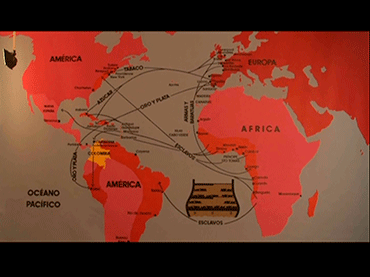
-
Sunday, 19 May 2019 - 7pm
Session 9. Paris Jazz: Anti-Racist Film in the Mainstream
Sabatini Building, Auditorium
Sarah Maldoror
Un dessert pour Constance
France, 1980, colour, original version in French with Spanish subtitles, digital archive, 60’Scala Milan A.C.
France, 2003, colour, original version in French with Spanish subtitles, digital archive, 18’Les oiseaux mains
France, 2005, colour, original version in French with Spanish subtitles, digital archive, 30’’Sarah Maldoror puts forward cinema that brings down identity stereotypes from the mainstream. These two films made for television come together to demonstrate the multi-culturalism of Parisian society, in spite of the predominant national culture: in the comedy Un dessert pour Constance, two street cleaners of African origin find a cookbook of classic French recipes, which they study for fun and become genuine experts, winning first prize in a typically middle class TV programme in France; in Scala Milan A.C., a group of suburban youths from different ethnic and geographical backgrounds decide to describe their neighbourhood to the rhythm of Archie Shepp’s jazz, shaping a poetic anthem to a racialised and invisible France. Finally, Les oiseaux mains is a brief animation on utopia in marginalisation, revealing the film-maker’s desire for continuous learning.
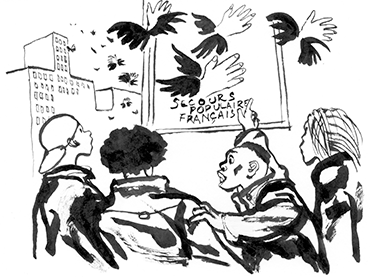
Sarah Maldoror, Négritude Poet and Film-maker
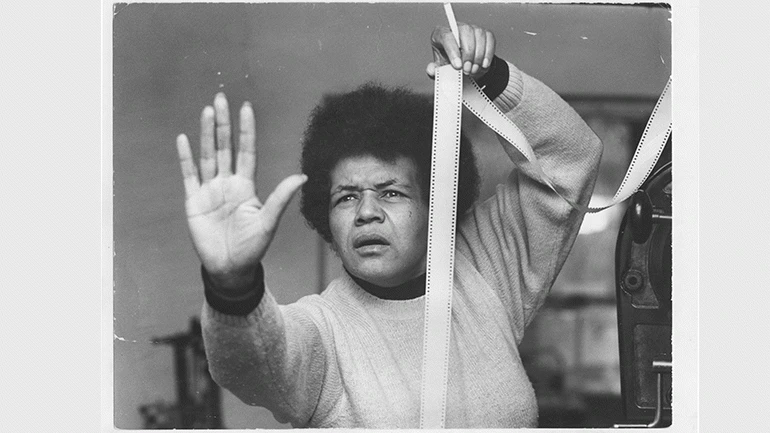
Held on 11, 18 May 2019
The first retrospective on Sarah Maldoror (Gers, France, 1929) in Spain rediscovers a vital film-maker whose work remains obscure, despite her huge commitment to the decolonial movement and the struggles for social diversity from 1960 onwards. Born Sarah Ducados to an Antillean father and a French mother, she took on the name Maldoror in homage to Les Chants de Maldoror (The Songs of Maldoror) by Lautréamont, a poet admired by the Surrealists. Such a gesture sought to breathe life into Surrealism from the tenets of Négritude, an artistic, social and political movement she would become a major exponent of, with her work responding at once to the search for poetic form with which to express an alternative identity and the promise of a future society offering new black culture emanating from anti-colonialism and Pan-Africanism during the 1960s.
In 1961 Maldoror went to Moscow to study film, and it was there that she met Ousmane Sembène, the great Senegalese film-maker, and began working on vibrant and syncopated montages to rhythms of jazz and black music. Upon her return to France she joined the struggles of the African emancipation movements, complementing her films with essays by Amílcar and Luis Cabral, Joaquim and Mário de Andrade. A condemnation of the colonialist system is at the core of her best-known films: Monangambée, Sambizanga and La battaglia di Algeri (The Battle of Algiers), in which she collaborated as assistant director to Gillo Pontecorvo.
The aforementioned films, shot in Algeria and the Congo at the height of anti-colonial uprisings, denounce the repression of people and the use of torture against guerrillas from an anti-racist and feminist perspective of emancipation, in keeping with the film-maker’s oeuvre. Despite a strong political commitment, her work eschewed propaganda, so much so that Algeria’s revolutionary government considered her first feature, Des fusils pour Banta, too ambiguous and seized it – the film has not seen the light of day until now. The thrilling prospect of a society without Western rule paved the way for a new line of work, in which African identity is explored through festivals and carnivals, leading to a collaboration with William Klein in the huge 1969 fresco Festival panafricain d'Alger (The Pan-African Festival of Algiers), showing the carnivals of Cape Verde and Guinea-Bissau.
In the wake of this militant period, Maldoror approached Négritude as a poetics of difference. Based on Pan-Africanism, anti-colonialism and the synthesis between Marxism and Surrealism, Négritude is a cultural movement founded by poets Aimé Cesaire (Martinica, 1913–2018), Leopold Senghor (Senegal, 1906–2001) and Leon G. Damas (France, 1912–1978). It had such a strong influence on Sarah Maldoror that her films would be defined as a translation of the three writers’ poetry into images and sound, a visual manifesto of Négritude manifested in the consideration of identity as the result of relations, the constant presence of orality, the poetic word, and the frenetic rhythm of sonorous music.
Curatorship
Chema González
Locations
Museo Nacional Centro de Arte Reina Sofía
Sabatini Building, Auditorium - Santa Isabel, 52
Matadero Madrid
Cinematheque, Azcona and Borau Theatres – Plaza de Legazpi, 8
With the support of
Acknowledgements
Embassy of Algeria in Spain, Cinematheque of Algeria, Ministère de l'Europe et des Affaires étrangères, Center national du cinéma et de l'image animée (CNC) and CNRS Images
Organised by
Museo Reina Sofía and DocumentaMadrid 2019 (16th International Documentary Film Festival)

Participants
Annouchka de Andrade is Sarah Maldoror’s daughter and one of the main figures behind the recovery of her work.
Mathieu Klebeye Abonnenc is an Antillean artist whose work approaches Sarah Maldoror’s and who looks to rebuild the affection and personal threads of the early decolonial movement.
Olivier Hadouchi is a researcher, professor and independent programmer who has worked tirelessly to recover militant and decolonial cinema from the 1960s and 1970s.
Chema González is head of the Museo Reina Sofía’s Cultural Activities and Audovisuals and the curator of this series.
Itinerancies
Buenos Aires, Argentina
22 September, 2020 - 29 September, 2020
Más actividades

Difficulty. Forms and Political Effects of Deviation in Writing and Contemporary Art
23 February – 14 December 2026 – Check programme
Difficulty. Forms and Political Effects of Deviation in Writing and Contemporary Art is a study group aligned towards thinking about how certain contemporary artistic and cultural practices resist the referentiality that dominates the logics of production and the consumption of present-day art. At the centre of this proposal are the concepts of difficulty and deviation, under which it brings together any procedure capable of preventing artistic forms from being absorbed by a meaning that appears previous to and independent from its expression. By ensuring the perceptibility of their languages, difficulty invites us to think of meaning as the effect of a signifying tension; that is, as a productive and creative activity which, from the materiality of art objects, frees aesthetic experience from the representational mandate and those who participate in it from the passiveness associated with tasks of mimesis and decoding.
The economy of the referential norm translates the social logic of capitalism, where insidious forms of capturing subjectivity and meaning operate. In the early 1980s, and adopting a Marxist framework, poet Ron Silliman highlighted how this logic entailed separating language from any mark, gesture, script, form or syntax that might link it to the conditions of its production, rendering it fetichised (as if without a subject) and alienating its users in a use for which they are not responsible. This double dispossession encodes the political strategy of referential objectivity: with no subject and no trace of its own consistency, language is merely an object, that reality in which it disappears.
The political uses of referentiality, more sophisticated today than ever before, sustain the neoliberal-extractivist phase of capitalism that crosses through present-day societies politically, economically and aesthetically. Against them, fugitive artistic practices emerge which, drawing from Black and Queer studies and other subaltern critical positions, reject the objective limits of what exists, invent forms to name what lies outside what has already been named, and return to subjects the capacity to participate in processes of emission and interpretation.
Read from the standpoint of artistic work, the objective capture of referentiality may be called transparency. Viewed from a social contract that reproduces inequality in fixed identity positions, transparent in this objectivity are, precisely, the discourses that maintain the status quo of domination. Opposite the inferno of these discourses, this group aims to collectively explore, through deviant or fugitive works, the paradise of language that Monique Wittig encountered in the estranged practices of literature. For the political potency of difficulty — that is, its contribution to the utopia of a free language among equals — depends on making visible, first, its own deviations; from there, the norm that those deviations transgress; and finally, the narrowness of a norm which in no way exhausts the possibilities ofsaying, signifying, referring and producing a world.
From this denouncement of referential alienation, fetishisation and capture, Difficulty. Forms and Political Effects of Deviation in Writing and Contemporary Art turns its attention to the strategies of resistance deployed by contemporary artists and poets. Its interest is directed towards proposals as evidently difficult or evasive as those of Gertrude Stein, Lyn Hejinian, Theresa Hak Kyung Cha, Kameelah Janan Rasheed, Kathy Acker, María Salgado and Ricardo Carreira, and as seemingly simple as those of Fernanda Laguna, Felix Gonzalez Torres and Cecilia Vicuña, among other examples that can be added according to the desires and dynamics of the group.
The ten study group sessions, held between February and December, combine theoretical seminars, work with artworks from the Museo Reina Sofía’s Collections and exhibitions, reading workshops and public programs. All these formats serve as spaces of encounter to think commonly about certain problems of poetics — that is, certain political questions — of contemporary writing and art.
Difficulty. Forms and Political Effects of Deviation in Writing and Contemporary Art inaugurates the research line Goodbye, Representation, through which the Museo Reina Sofía’s Studies Directorship seeks to explore the emergence of contemporary artistic and cultural practices which move away from representation as a dominant aesthetic-political strategy and redirect their attention toward artistic languages that question the tendency to point, name and fix, advocating instead for fugitive aesthetics. Over its three-year duration, this research line materializes in study groups, seminars, screenings and other forms of public programming.

CLINIC 2628. A Community of Writing and Research in the Arts
February – October 2026
Clinic 2628 is a project which supports and brings together writings which stem from the intention to offer a space and sustainable time for research work in art and culture. Framed within an academic context which is increasingly less receptive to the forms in which thinking happens and is expressed, the aim is to rescue the academic from its neoliberal trappings and thus recover the alliance between precision and intuition, work and desire. A further goal is to return writing to a commons which makes this possible through the monitoring of processes and the collectivisation of ideas, stances, references and strategies.
The endeavour, rooted in a collaboration between the Museo Reina Sofía’s Studies Directorship and the Artea research group, via the i+D Experimenta project, is shaped by three annual editions conceived as spaces of experimentation, discussion and a demonstration of writings critical of what is put forward by today’s academia.
What forces, forms and processes are at play when writing about art and aesthetics? In academia, in museums and in other cultural institutions, the practice of writing is traversed by productivist logics which jeopardise rhythms of research and experimentation. The imposition of both scientism inherent in the structure of “the paper” and the quantifying of results which demand a criterion of quality and visibility sterilise and smoothen, from the outset, the coarseness that is particular to writing understood from the concrete part of language: phonic, graphic, syntactic and grammatical resistance connecting the language user to the community the language unites and activates. They also sterilise the roughness enmeshed in the same desire to write, the intuitive, clear and confusing pathways that once again connect the writer to those reading and writing, participating in a common good that is at once discovered and produced.
The progressive commercialisation of knowledge propelled by cognitive capitalism moves further away from the research and production of knowledge in artworks and artistic languages and practices. The work of curators and archive, criticism, performances and essays formerly saw a horizon of formal and emotional possibilities, of imagination that was much broader when not developed in circumstances of competition, indexing and impact. Today, would it be possible to regain, critically not nostalgically, these ways; namely, recovering by forms, and by written forms, the proximity between art thinking and its objects? How to write in another way, to another rhythm, with no more demands than those with which an artwork moves towards different ways of seeing, reading and being in the world?

Cultural Work
Thursday, 12 February 2026 – 5:30pm
This series is organised by equipoMotor, a group of teenagers, young people and older people who have participated in the Museo Reina Sofía’s previous community education projects, and is structured around four themed blocks that pivot on the monstrous.
Session number two looks to approach film as a place from which cultural work is made visible and processes of production engage in dialogue with artistic creation. From this premise, the session focuses on exploring how audiovisual content is produced, assembled and distributed, from the hands that handle the images to the bodies that participate in its circulation. The aim is to reflect on the invisible effort, precarity and forms of collaboration that uphold cultural life, that transform the filmic experience into an act that recognises and cares for common work.

The (legal) person and the legal form. Chapter II
8, 12, 15 January, 2026 – 16:00 to 19:00
As part of the Studies Constellation, the Study Directoship’s annual fellowship, art historian and theorist Sven Lütticken leads the seminar The (Legal) Person and the Legal Form: Theoretical, Artistic, and Activist Commitments to foster dialogue and deepen the hypotheses and questions driving his research project.
This project, titled Unacting Personhood, Deforming Legal Abstraction, explores the dominance of real abstractions—such as exchange value and legal form—over our processes of subjectivation, and asks how artistic practices can open up alternative ways of representing or performing the subject and their legal condition in the contemporary world.
The seminar consists of eight sessions, divided into three chapters throughout the academic year. While conceived as non-public spaces for discussion and collective work, these sessions complement, nourish, and amplify the public program of the Studies Constellation.
In this second chapter of the seminar, the inquiry into the aesthetics and politics of legal form continues with three sessions that pick up the discussions held in Chapter I but propose new lines of flight. The first session focuses on international law via the writings of the British author China Miéville, which allows us to reconsider the notion of the legal form –following Evgeny Pashukanis— and, through it, a variety of (people’s) tribunals. While the crucial concept of the legal person –as the right-holder central to the form of law— was debated in Chapter I, the second session focuses on attempts to extend personhood not (just) to corporations, but rather to nonhuman animals or ecosystems. Finally, the third session poses the question: how can groups and networks use officially recognized organizational forms (such as the foundation or the cooperative) and/or use a collective persona (without necessarily a legal “infrastructure” to match) to act and represent themselves?

TEJA 2026. Open Call for Emergency Art Residencies
Proposal submission until 12 January, 2026
TEJA / Red de espacios culturales en apoyo a situaciones de emergencia [Network of Cultural Spaces in Support of Emergency Situations] has the mission to promote transnational cooperation by offering temporary art residencies to artists and cultural practitioners who find themselves in complex socio-political situations in their countries of origin. During their stay in Spain, residents receive accommodation, legal and psychological counseling, and access to a network of organizations and professionals with whom they can share, develop, and continue with their creative projects. The goal is to provide a safe and stimulating environment where artists can continue their work despite adverse circumstances and generate dialogue spaces that ensure freedom of expression through joint activities both in Spain and with international collaborators.
During 2026, TEJA hosts three new residencies, each lasting three months, dedicated to supporting artists and cultural practitioners residing in the West Bank and Jerusalem. In addition, in the second half of the year, TEJA hosts three additional residencies for Gazan artists, which are offered by invitation (as Spain is currently unable to facilitate evacuations from Gaza, these invitations are coordinated through France). These residencies aim to provide a stable, creative environment and foster artistic exchange in the face of ongoing adversities. Through this new program, TEJA reaffirms its commitment to amplifying Palestinian voices and empowering artists as they navigate these turbulent times.
The selection is carried out by the TEJA network in close collaboration with each hosting partner. This year the hosting partners are: La Escocesa (Barcelona), hablarenarte / Planta Alta (Madrid), Espositivo (Madrid), Institute for Postnatural Studies (Madrid), Casa Árabe (Córdoba). The selection prioritizes the artist’s personal and professional situation first, and then the alignment with the practices and themes of the hosting spaces. Proposal submission deadline is January 12th, 2026, 23:59 h.
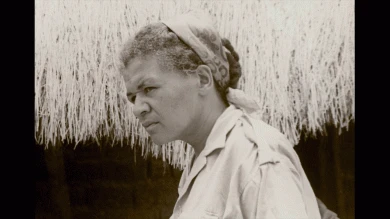
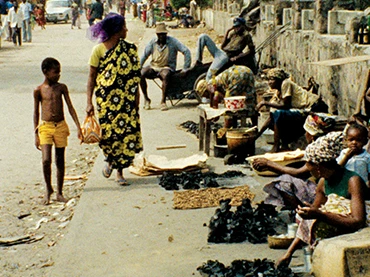



![Miguel Brieva, ilustración de la novela infantil Manuela y los Cakirukos (Reservoir Books, 2022) [izquierda] y Cibeles no conduzcas, 2023 [derecha]. Cortesía del artista](https://recursos.museoreinasofia.es/styles/small_landscape/public/Actividades/ecologias_del_deseo_utopico.jpg.webp)
![Ángel Alonso, Charbon [Carbón], 1964. Museo Reina Sofía](https://recursos.museoreinasofia.es/styles/small_landscape/public/Actividades/perspectivas_ecoambientales.jpg.webp)